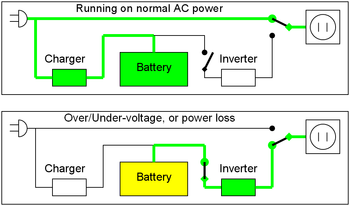
Uninterruptible power supply
An uninterruptible power supply (UPS), also known as a continuous power supply (CPS) or a battery backup is a device which maintains a continuous supply of electric power to connected equipment by supplying power from a separate source when utility power is not available. It differs from an auxiliary power supply or standby generator, which does not provide instant protection from a momentary power interruption, however could be used to provide uninterrupted power to equipment for 1 - 20 minutes until a generator can be turned on. Integrated systems that have UPS and standby generator components are often referred to as emergency power systems.
There are three distinct UPS types :
- off-line : remains idle until a power failure occurs, and then switches from utility power to its own power source, almost instantaneously.
- line-interactive.
- on-line : continuously powers the protected load from its energy reserves stored in a lead-acid battery or flywheel, while simultaneously replenishing the reserves from the AC power. It also provides protection against all common power problems, and for this reason it is also known as a power conditioner and a line conditioner.
While not limited to safeguarding any particular type of equipment, a UPS is typically used to protect computers, telecommunication equipment or other electrical equipment where an unexpected power disruption could cause injuries, fatalities, serious business disruption or data loss. UPS units come in sizes ranging from units which will back up a single computer without monitor (around 200 VA) to units which will power entire data centers or buildings (several megawatts).
Historically, UPSs were expensive and were most likely to be used on expensive computer systems and in areas where the power supply is interrupted frequently. As prices have fallen, UPS units have become an essential piece of equipment for data centers and business computers, and are also used for personal computers, entertainment systems and more.
Offline / standby
The Offline / Standby UPS offers only the most basic features, providing surge protection and battery backup. Usually the Standby UPS offers no battery capacity monitoring or self-test capability, making it the least reliable type of UPS since it could fail at any moment without warning. These are also the least expensive, selling for as little as US$75. The Standby UPS may be worse than using nothing at all, because it gives the user a false sense of security of being assurred protection that may not work when needed the most.
With this type of UPS, a user's equipment is normally connected directly to incoming utility power with the same voltage transient clamping devices used in a common surge protected plug strip connected across the power line. When the incoming utility voltage falls below a predetermined level the UPS turns on its internal DC-AC inverter circuitry, which is powered from an internal storage battery. The SBS then mechanically switches the connected equipment on to its DC-AC inverter output. The switch over time is stated by most manufacturers as being less than 4 milliseconds, but typically can be as long as 25 milliseconds depending on the amount of time it takes the Standby UPS to detect the lost utility voltage.
Line-interactive
The Line-Interactive UPS is similar in operation to a Standby UPS, but with the addition of a multi-tap variable-voltage autotransformer. This is a special type of electrical transformer that can add or subtract powered coils of wire, thereby increasing or decreasing the magnetic field and the output voltage of the transformer.
This type of UPS is able to tolerate continuous undervoltage brownouts and overvoltage surges without consuming the limited reserve battery power. It instead compensates by auto-selecting different power taps on the autotransformer. Changing the autotransformer tap can cause a very brief output power disruption, so the UPS may chirp for a moment, as it briefly switches to battery before changing the selected power tap.
Autotransformers can be engineered to cover a wide range of varying input voltages, but this also increases the number of taps and the size, weight, complexity, and expense of the UPS. It is common for the autotransformer to only cover a range from about 90v to 140v for 120v power, and then switch to battery if the voltage goes much higher or lower than that range.
In low-voltage conditions the UPS will use more current than normal so it may need a higher current circuit than a normal device. For example to power a 1000 watt device at 120 volts, the UPS will draw 8.32 amps. If a brownout occurs and the voltage drops to 100 volts, the UPS will draw 10 amps to compensate. This also works in reverse, so that in an overvoltage condition, the UPS will need fewer amps of current.



No comments:
Post a Comment